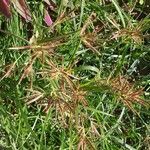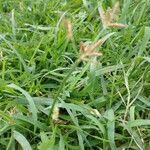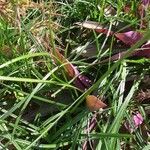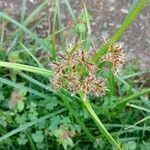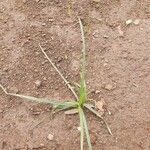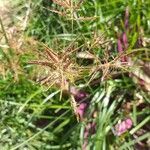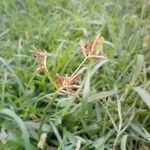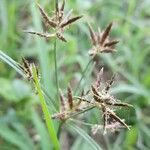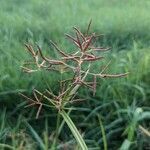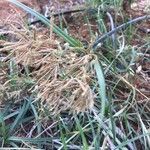Herbs, perennial, stoloniferous; stolons (2–)5–12 cm × 1–2 mm, bearing tubers 3–8(–12) mm diam., wiry, springy when dried, indurate. Culms trigonous, 10–35(–40) cm × 0.7–3.4 mm, basally indurate, glabrous. Leaves V-shaped to flanged V-shaped, 5–30 cm × 2–6 mm. Inflorescences: spikes 1(–3), broadly ellipsoid, (12–)15–25(–30) × (12–)20–30(–50) mm; rays (3–)4–6(–7), 0.2–10 cm; bracts (2–)3–5, horizontal to ascending at 45°, V-shaped to flanged V-shaped, 0.5–10 cm × 0.5–4 mm; rachilla persistent, wings 0.5–1 mm wide. Spikelets (2–)3–7(–12), compressed, linear, 4–40 × 1.3–1.8 mm; floral scales persistent, 6–36(–42), spreading or appressed, purple to reddish brown, with narrow clear border and green midrib, 7–9-ribbed, ovate, (1.8–)2.6–3.4 × 2.2–3 mm, apex obtuse. Flowers: anthers 1–2.5 mm; styles 1.3–3.5 mm; stigmas (1.8–)2–3.3 mm. Achenes black, sessile, ellipsoid, abaxial face convex, adaxial face concave, 1.4–1.7(–1.9) × 0.8–1 mm, apex obtuse, surfaces puncticulate.
Rhizome wiry, far-extending, with prominent, ellipsoid, often fibrous-coated tubers. Stems 10-35 cm high, 3-angled, with many leaves at ± bulbous base. Leaves usually < stems, 2-3 mm wide double-folded, recurved at maturity, margins scabrid towards tip; sheaths dark brown. Involucral bracts 2-4, leaf like, lowest ± = inflorescence. Inflorescence usually a simple umbel with few slender rigid rays. Spikelets dark brown in digitate clusters of 3-10, linear, compressed, subacute, ± 5-15 × 1-2 mm. Rhachilla winged. Glumes ± 3 mm long, ± densely imbricate, ovate, obtuse, membranous, deep red-brown or red-purple with green keel, ± nerved. Stamens 3. Style-branches 3. Nut trigonous, obovoid, much < glume, rarely maturing.
Perennial with numerous slender rhizomes ending in small tubers; stems 2–5 dm, smooth; lvs basally disposed, mostly shorter than the stem, 3–6 mm wide; bracts few, all or all but one shorter than the infl; rays 3–7, simple or sometimes branched at the top, to 10 cm; spikelets 3–10 in short-cylindric spikes, 10–40-fld, to 4 cm; scales closely imbricate, ovate, 2.5–3.5 mm, obtuse, keeled, 7-nerved (3 in the midvein, 2 nearby on each side), the sides purple-brown or red-brown; rachilla persistent, winged; achenes nearly black, narrowly trigonous-obovoid, 1.5 mm; 2n=108. A weed of sandy soil; pantrop., n. to Va. and Ky., and occasionally adventive farther n.
Perennial herb, aerial parts deciduous, 0.20-0.65 m high, long-rhizomatous, rhizomes slender, wiry, bearing small, fibrous, blackish tubers at intervals. Leaf blades 2.5-4.5 mm wide, flat. Culm scapose, 3-angled, 1-2 mm in diam. at middle. Inflorescence a compound anthela, very variable in size and degree of branching. Subtending bracts 3 or 4, leaf-like. Spikelets compressed, linear-oblong, 7-10(-20) x 2 mm, 12-24-flowered. Glumes lanceolate, ± 2.8 mm long, keel excurrent into a minute point. Flowering time Feb. Nutlet (mature ones seldom collected) oblong to obovate, 1.5-1.7 x 0.8 mm, 3-angled, dark brown appearing grey, surface finely reticulate.
A sedge. It is a herb that continues growing from year to year. It has both rhizomes and tubers under the ground. The leaves of this plant have a blunt tip and do not have a shoulder along the leaf. The leaves mostly grow from the base of the plant. They are narrow and flat and 5-20 cm long. The flower is a compound flower with 5 leafy bracts near the base of the flower. These are of different lengths. The flower stem is 3-angled and 20-50 cm high. The fruit are 3 angled and brown. They are about 1.5 mm long. The tubers of this species are dark brown, in a chain and have a bitter or unpleasant taste.
Perennial, the rhizomes sometimes tuber-bearing; culms slender, 10-60 cm. high, bulbous-thickened at the base; leaves 2-6 mm. wide; bracts usually short; spikes ovate, lax, on rays to 6 cm. long; spikelets linear, 1-2 cm. long, 12-to 30-flowered, rachilla winged; scales purplish, carinate, obtuse, obscurely nerved; achene obovate-ellipsoid, bluntly trigonous, 1.5 mm. long, black, minutely papillose, maturing only infrequently.
Large spikelets, characteristically dark red-brown, in short spikes
Rounded, fibre-covered tubers at the stem bases
Tuberous perennial to 15 cm. Spikelets red.
Slender, elongated rhizomes
Common weed
